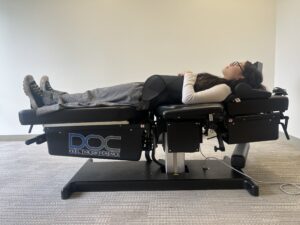
Nerve pain in the back can be debilitating—stealing your joy and making living active and well nearly impossible. Even simple tasks become challenging.
As a chiropractor, I often see patients struggling with various types of back pain, and I can say that nerve-related issues are some of the worst kinds of pain to have. But I have some hopeful news for you today. Many causes can be treated without surgery or potentially dangerous medications.
What is Nerve Pain in the Back?
Nerve pain, or neuropathic pain, occurs when nerves are damaged or irritated. In this case, the nerves in question are in the spine. Many people are surprised to learn this since they feel this pain on the left or right side, not the spine.
But that’s because these large nerves radiate the sensation out from the center and down the body.
As a chiropractor, I can deduce where the nerve irritation is occurring in the spine based on the location of the nerve pain symptoms—from behind your shoulder down to the back of your thigh.
I’m able to do this because the nerves that begin in your spinal column take a specific path through the human body—carrying the pain with them.
Symptoms of Nerve Pain in the Back
You might experience nerve pain of the back as:
- Burning
- Sharp
- Dull persistent ache
- Tingling
- Numbness
- Radiating
- Muscle weakness
It’s usually only on one side and often comes and goes as you change positions.
For example, you might feel a sudden sharp pain in the mid-back. It catches you off guard, takes your breath away, and forces you to recoil from whatever you were doing.
A moment later, it passes. But now you’re afraid to move because it hurts. That’s no way to live!
And sadly, this lack of movement makes it worse over time.
The constant worry about the pain may also impact your mental health and sense of well-being. And in severe cases, the pain is so bad it physically keeps you from moving. You may not be able to sit, bend, or stand up straight.
You may also want to check out Peripheral Nerve Pain Symptoms: Your Body’s Alarm System.
What Causes Nerve Pain Back?
Common causes of back nerve pain include herniated discs, spinal stenosis, and pinching or tightness of the sciatic nerve.
In each of these, a nerve is trapped between the spinal discs. When this happens, the bone is allowed to rub/squeeze the nerve.
Herniated (ruptured) discs can happen anywhere along the spine. Discs are cushions between each back bone to protect your spinal nerves and the bones from damage. But these discs can become compressed like a water balloon in your hand. This allows the bones to get too close to each other, leading to structural issues. If that disc is squeezed hard enough, it bursts. It’s not quite as dramatic a burst as a water balloon. But it does slowly leak an irritating fluid onto the nerve.
Spinal stenosis is a narrowing of the spinal column. It often happens in the neck, leading to nerve pain behind the shoulder as well as upper back nerve pain.
When the lower spinal column (the lumbar spine) narrows, it puts pressure on the sciatic nerve, leading to Sciatica. The sciatic nerve nerve runs from the lower back, down each hip and into the back of your thigh. So, you may feel the pain in one or all three places.
An estimated 40% of people will experience sciatic nerve pain in the lower back during their lifetime.

If one of these three causes contributes to your nerve pain, you don’t have to just live with it. This is a mechanical problem in the back.
When the structural issue is correctable with an adjustment, I can release the nerve and allow the nerve to heal. With proper care and a periodic adjustment you can maintain the pain relief long-term.
It’s essential to seek professional help to determine whether a spinal adjustment could help your nerve pain in the back.
To find out, Schedule your initial consultation for a full evaluation and first treatment.
Diagnosis
To diagnose nerve pain in the back, a thorough medical history and physical examination are necessary. Diagnostic tests like MRI, CT scans, and X-rays can help pinpoint precisely where the nerve is trapped.
But chiropractors also train for years. As part of our education, we learn how to feel the irregularities in the spine before correcting them.
Treatment Options
Depending on the cause and severity, you may need a combination of therapies or treatments. Your chiropractor can work with your medical professional team to help you get the best results.
Non-Surgical Treatments
- Medications: Over-the-counter pain relievers, anti-inflammatories, and prescription medications can help manage the pain.
- Home Exercise Program: Strengthening and stretching exercises can alleviate pain and improve mobility. Your chiropractor will show you how to perform exercises to strengthen the supporting muscloskelatal system and support nerve health.
- Chiropractic Care: Regular adjustments can relieve nerve pain in the back and improve spinal alignment.
- Acupuncture: This ancient practice can provide short-term relief for many patients, giving the nerve time to heal.
- Lifestyle Changes: Maintaining a healthy weight and staying active can significantly reduce back pain. If you have a desk job that keeps you sedentary, we can work with you on strategies to support more movement throughout the day.
Surgical Treatments
While not the first choice for most patients, surgical options are available through an orthopaedist. We can work with your doctor to attempt less invasive treatment before you decide to go under the knife. We also become an important part of your post-surgical rehabilitation and pain-free maintenance plan.
Some surgeries your doctor might consider include:
- Discectomy: Removing the disc’s herniated part can relieve nerve pressure.
- Laminectomy: Removing part of the vertebra can relieve pressure on the spinal cord or nerves.
- Spinal Fusion: This surgery joins two or more vertebrae together to provide stability.
Pain Management Strategies
Managing nerve pain in the back involves both at-home and professional strategies.
At-Home Pain Relief Methods
- Heat and Ice Therapy: Alternating between heat and ice can reduce inflammation and pain.
- Over-the-Counter Pain Relievers: These can help manage mild to moderate pain.
- Gentle Stretching and Exercise: Regular movement can keep your back flexible and reduce pain.
Professional Pain Management Techniques
- Epidural Steroid Injections: These can reduce inflammation around the nerves.
- Nerve Blocks: Injecting anesthetics near the nerves can provide temporary relief.
- Radiofrequency Ablation: Burning the nerves to relieve back pain can provide long-term relief.
- Acupuncture: Increases blood flow and can encourage the activation of your body’s natural painkillers and healing processes.
Preventing Nerve Pain
Prevention is better than cure. Whether you’ve recently recovered from back nerve pain or you’re trying to reverse the pain before it gets worse, here are some tips to keep your back healthy and pain-free.
Ergonomic Tips for Daily Activities
- Proper Lifting Techniques: Lift with your legs, not your back. To learn more, check out our article on lifting form.
- Correct Posture: Maintain a neutral spine while sitting and standing.
- Ergonomic Office Setups: Ensure your workstation supports good posture, ideally with a sit and stand option.
We take time to show patients what proper form looks like and help them achieve it. Our goal is to see patients live pain-free through comprehensive pain management strategies.

Regular Exercise and Stretching
- Strengthening Exercises: Focus on your core and back muscles.
- Flexibility Exercises: Stretching can prevent tightness and pain.
- Walking: If you are able, walking more around the house, neighborhood, or office can promote better posture. You engage multiple core muscles with this one action, which can alleviate pressure on the spinal discs.
- Balance: Exercise methodologies, such as those found in yoga and Pilates, promote balance and stability.
Learn about the top 5 stretches for sciatica and how to do them step-by-step.
Healthy Lifestyle Habits
- Balanced Diet: Proper nutrition supports overall health. Of course, a balanced diet is important, but some nutrients have moderate to strong evidence and are worth a try. On the whole food side, these include dark leafy greens and green vegetables, berries, sweet potatoes, turmeric, avocado, and quinoa. These foods provide key nutrients like B vitamins, antioxidants, fiber, potassium, magnesium, and known anti-inflammatory compounds.
- Adequate Sleep: Good sleep is essential for recovery and pain management. Adjust your pillows and positions to ensure your sleeping style doesn’t inadvertently cause structural issues.
- Stress Management: Techniques like mindfulness and meditation can reduce stress and pain.
Living with Nerve Pain
Coping with chronic pain requires a multi-faceted approach.
- Mindfulness and Meditation: These can help manage pain and improve mental well-being.
- Support Groups and Counseling: Connecting with others who understand your pain can provide emotional support.
- Pain Management Programs: Professional programs can offer comprehensive pain management plans.
- Functional Medicine / Integrative Care: A chiropractor is an important part of your functional medicine team since we offer less invasive and effective treatments for back pain.
- Medical Care: If less invasive treatments do not provide sufficient relief, medical doctors can prescribe medications and surgical treatment.
Exercises for Sciatic Nerve Back Pain
Exercises play a crucial role in managing sciatic nerve pain in the back. Here are some effective exercises:
- Piriformis Stretch: This can relieve back nerve pain down the leg.
- Hamstring Stretch: Keeping your hamstrings flexible can reduce lower back pain.
- Pelvic Tilts: These strengthen your core and lower back muscles and help with sciatic nerve pain in the back
You Can Live Pain-Free
Nerve pain in the back can be managed effectively with the right approach. From professional treatments to at-home care, there are many ways to find relief. Remember, maintaining a healthy lifestyle and seeking professional help when needed are crucial steps in managing and preventing back pain. To learn how to live without pain, schedule your initial consultation for a full evaluation and first treatment.



